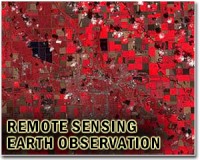 |
Pasadena CA (JPL) Mar 14, 2011 The extent of inundation from the destructive and deadly tsunami triggered by the March 11, 2011, magnitude 8.9 earthquake centered off Japan's northeastern coast about 130 kilometers (82 miles) east of the city of Sendai is revealed in this before-and-after image pair from the Multi-angle Imaging SpectroRadiometer (MISR) instrument on NASA's Terra spacecraft. The new image, shown on the right, was acquired at 10:30 a.m. local time (01:30 UTC) on March 12, 2011. For comparison, shown on the left is a MISR image from about 10 years ago, on March 16, 2001, acquired under nearly identical illumination conditions. Flooding extending more than 4 kilometers (2.5 miles) inland from the eastern shoreline is visible in the post-earthquake image. The white sand beaches visible in the pre-earthquake view are now covered by water and can no longer be seen. Among the locations where severe flooding is visible is the area around Matsukawa-ura Bay, located just north and east of the image center. From top to bottom, each image extends from just north of the Abukuma River (about 21 kilometers, or 13 miles, south of Sendai) to south of the town of Minamisoma (population 71,000, located in Japan's Fukushima Prefecture about 70 kilometers, or 44 miles, south of Sendai). The images cover an area of 78 kilometers (48 miles) by 104 kilometers (65 miles). These unique images enhance the presence of water in two ways. First, their near-infrared observations cause vegetated areas to appear red, which contrasts strongly with the blue shades of the water. Second, by combining nadir (vertical-viewing) imagery with observations acquired at a view angle of 26 degrees, reflected sunglint enhances the brightness of water, which is shown in shades of blue. This use of different view-angle observations causes a stereoscopic effect, where elevated clouds have a yellow tinge at their top edges and blue tinge at their bottom edges.
NASA Shows Topography of Tsunami-Damaged Japan City On March 11, 2011, a magnitude 8.9 earthquake struck offshore about 130 kilometers (80 miles) east of Sendai, the capital city of Japan's Miyagi Prefecture, generating a tsunami that devastated the low-lying coastal city of about 1 million residents. The city is centered in the image and lies along the coastal plain between the Ohu Mountains and the Pacific Ocean. The eastern part of the city is a low-lying plains area, while the city center is hilly (the city's official elevation is about 43 meters, or 141 feet). Sendai's western areas are mountainous, with its highest point being Mt. Funagata at an elevation of about 1,500 meters (4,921 feet) above sea level. According to the U.S. Geological Survey, the earthquake occurred as a result of thrust faulting on or near the subduction zone interface plate boundary between the Pacific and North America plates. At the latitude of this earthquake, the Pacific plate moves approximately westwards with respect to the North America plate at a velocity of 83 millimeters (3.3 inches) per year. The Pacific plate thrusts underneath Japan at the Japan Trench, and dips to the west beneath Eurasia. The location, depth and focal mechanism of the March 11 earthquake are consistent with the event having occurred as thrust faulting associated with subduction along this plate boundary. This image combines a radar image acquired in February 2000 during the SRTM mission, and color-coding by topographic height using data from the same mission. Dark green colors indicate low elevations, rising through yellow and tan, to white at the highest elevations. The Shuttle Radar Topography Mission is a cooperative project between NASA, the National Geospatial-Intelligence Agency (NGA) of the U.S. Department of Defense and the German and Italian space agencies. It is managed by NASA's Jet Propulsion Laboratory, Pasadena, Calif., for NASA's Science Mission Directorate, Washington, D.C.
Share This Article With Planet Earth
Related Links Multi-angle Imaging SpectroRadiometer at JPL Earth Observation News - Suppiliers, Technology and Application
 OSI Geospatial to supply New Zealand navy
OSI Geospatial to supply New Zealand navyWellington, New Zealand (UPI) Mar 11, 2011 OSI Geospatial signed a $2 million contract with Siemens to provide an Integrated Bridge System for the New Zealand navy's frigate Platform System Upgrade Program. The contract calls for OSI to deliver two of its Integrated Navigation and Tactical Systems for the ANZAC class frigates. OSI also will work with Siemens to integrate Siemens' Integrated Platform Management System into ... read more |
|
| The content herein, unless otherwise known to be public domain, are Copyright 1995-2010 - SpaceDaily. AFP and UPI Wire Stories are copyright Agence France-Presse and United Press International. ESA Portal Reports are copyright European Space Agency. All NASA sourced material is public domain. Additional copyrights may apply in whole or part to other bona fide parties. Advertising does not imply endorsement,agreement or approval of any opinions, statements or information provided by SpaceDaily on any Web page published or hosted by SpaceDaily. Privacy Statement |